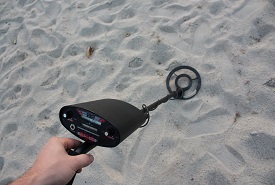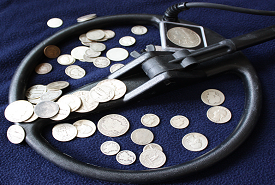Why do I Need a Dedicated Gold Metal Detector?
Finding gold in its natural form can be very exciting. Using a metal detector especially designed for gold hunting is essential. One of the largest obstacles is the ground where the gold may be. Most gold is in highly mineralized ground meaning the ground contains iron. This mix of iron in the soil causes most metal detectors to “false”, sounding off constantly because they are sensing those minerals in the ground. Another common fake target are known as “hot rocks”. These are rocks that have a high amount of mineralization and will set your detector off as well. Finally, natural gold doesn’t show up as nice uniform nuggets the size of your fist. They are much smaller, irregular shaped and require a very sensitive machine. The specialized gold metal detectors below are designed to get past these difficulties with pulse induction (PI) and very low frequency (VLF) ground balancing technology.
Here Are the Best Metal Detectors for Gold Hunting:
Fisher Gold Bug Pro
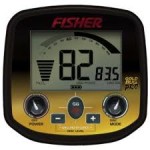 The Fisher Gold Bug Pro is one of the most popular detectors because it has a fast recovery time, computerized auto/manual ground balance, and has a great LCD screen. The Fisher Gold Bug Pro comes with a 5″ DD coil and runs at 19 KHz. The Fisher Gold Bug Pro is also lightweight (2.5 pounds) and has a 5 year warranty. The Fisher Gold Bug Pro is a really great machine due to its low price for dedicated gold metal detectors. Click here for the best price.
The Fisher Gold Bug Pro is one of the most popular detectors because it has a fast recovery time, computerized auto/manual ground balance, and has a great LCD screen. The Fisher Gold Bug Pro comes with a 5″ DD coil and runs at 19 KHz. The Fisher Gold Bug Pro is also lightweight (2.5 pounds) and has a 5 year warranty. The Fisher Gold Bug Pro is a really great machine due to its low price for dedicated gold metal detectors. Click here for the best price.
Garrett AT Gold
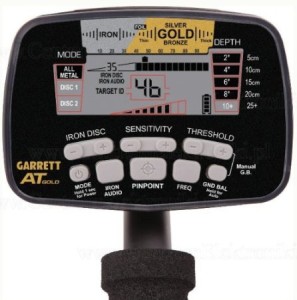 The Garrett AT Gold is popular because it has a fast recovery time, manual/automatic ground balance, and is waterproof to 10 feet. The fact that the detector is waterproof is great because you can search those streams and rivers for nuggets. The AT Gold comes with a 5×8″ DD coil and runs at 18 KHz. I have seen the Garrett AT Gold used as a beach hunter as well as a relic hunter due to its high sensitivity to small items. Similar to many other Garett detectors, the AT Gold is a versatile machine capable of hunting in many different locations for all kinds of objects inlcuding small gold. Click here for the best price.
The Garrett AT Gold is popular because it has a fast recovery time, manual/automatic ground balance, and is waterproof to 10 feet. The fact that the detector is waterproof is great because you can search those streams and rivers for nuggets. The AT Gold comes with a 5×8″ DD coil and runs at 18 KHz. I have seen the Garrett AT Gold used as a beach hunter as well as a relic hunter due to its high sensitivity to small items. Similar to many other Garett detectors, the AT Gold is a versatile machine capable of hunting in many different locations for all kinds of objects inlcuding small gold. Click here for the best price.
Tesoro Lobo
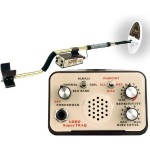 The Tesoro Lobo is a great gold metal detector. As with all Tesoro detectors it has a lifetime warranty, great price, and fast recovery time. The Tesoro Lobo comes with a 10″ elliptical coil and runs at 18 KHz. The Lobo has an automatic ground balance that adjusts based on the soil which can be helpful but without manual you will have to rely on the automatic ground balance. Click here for the best price.
The Tesoro Lobo is a great gold metal detector. As with all Tesoro detectors it has a lifetime warranty, great price, and fast recovery time. The Tesoro Lobo comes with a 10″ elliptical coil and runs at 18 KHz. The Lobo has an automatic ground balance that adjusts based on the soil which can be helpful but without manual you will have to rely on the automatic ground balance. Click here for the best price.
Minelab Eureka Gold
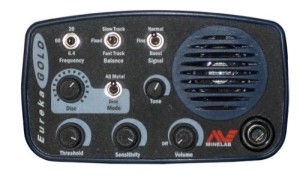 Minelab detectors have a great following because they offer great performance and the Minelab Eureka Gold is no exception. The Minelab Eureka Gold is a VLF detector and has a 10″ elliptical coil and runs at 6.4, 20, or 60 KHz with the flick of a switch. The change in kHz is going to depend on what type of gold you are after. Lower is for depth and larger nuggets while smaller gold that is closer to the surface would be found under the higher kHz. Click here for the best price.
Minelab detectors have a great following because they offer great performance and the Minelab Eureka Gold is no exception. The Minelab Eureka Gold is a VLF detector and has a 10″ elliptical coil and runs at 6.4, 20, or 60 KHz with the flick of a switch. The change in kHz is going to depend on what type of gold you are after. Lower is for depth and larger nuggets while smaller gold that is closer to the surface would be found under the higher kHz. Click here for the best price.
Minelab GPX 5000
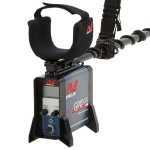 Looking for the king of the gold nugget metal detectors. The Minelab GPX 5000 is for the experienced gold hunter. This seem to be used in the Arizona and Australia gold fields with great success. This machine comes with a high price tag but professionals swear by it. Click here for the best price.
Looking for the king of the gold nugget metal detectors. The Minelab GPX 5000 is for the experienced gold hunter. This seem to be used in the Arizona and Australia gold fields with great success. This machine comes with a high price tag but professionals swear by it. Click here for the best price.
Where Should I Start Looking for Gold?
Here is the most important thing about looking for gold: research where gold has been found before. A common misconception is assuming that just because gold has been found in any certain area, you can just turn on your metal detector and start digging up gold. You need to be more precise in your research. The key is to look around and find evidence of prior miners. Any sign that gold has been found in the area before has the possibility that there is more to find. The early prospectors developed many innovative ways of finding gold. However, they didn’t have metal detectors. While it may be a pain digging up old iron trash, look on the bright side because it’s proof that there were people there in the past. The other important fact about gold is it is dense & heavy. This means that when it settles in the ground it sinks to the level where it is density is the same as the ground around it. That is why gold is commonly found on bedrock and with other heavy items like lead.
Here is Where to Look for Gold in the Desert:
Washes: Water is the great mover of gold. This is no exception in the desert. Desert gold is moved by flash flood. Washes funnel this activity and can be a great place to look for gold. The banks of washes can pay off as well. The key is to get to the bedrock, where gold settles after water movement.
Old Miner Evidence: Look for holes dug by dry-washers. Dry-washing equipment can miss gold when the dirt is placed on the machine. A dry-washer does not always separate wet dirt reliably and the gold can sometimes flow right out into the tailings.
Here is Where to Find Gold in the Mountains/Rivers:
Rivers & Streams: Bedrock on the sides of rivers and streams.
Old Miner Evidence: Examples include old placer tailing piles, holes from digging, rocks stacked up along a river or stream. Look for large areas dug up with bucket line dredges or big hydraulic pits. Check roads that were used for hauling ore. DO NOT go into old mines, they can be extremely dangerous due to fumes or unstable foundations.
Old River Channels: Metal detect the exposed bedrock. Just because there isn’t water flowing doesn’t mean it didn’t in the past.
